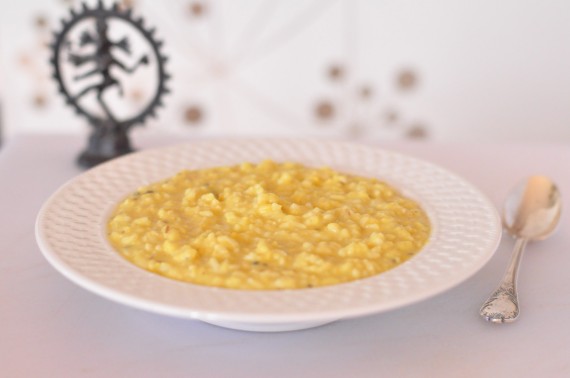 Do you ever feel like you're walking and thinking in a mud bog? Can you relate to feeling sluggish or stagnant, less vibrant than you know you can be? Maybe you suffer from extra weight or allergies? All of these are symptoms of your system being clogged. Before doing my first Ayurvedic detox, my "normal" was congested, lazy, and bloated. But after the cleanse, I experienced such a heightened level of mental clarity and physical vitality that I've made it something I do several times each year. It's actually pretty easy, and totally worth it, to take 8 days of your life and do everything in a different, clean way.
Do you ever feel like you're walking and thinking in a mud bog? Can you relate to feeling sluggish or stagnant, less vibrant than you know you can be? Maybe you suffer from extra weight or allergies? All of these are symptoms of your system being clogged. Before doing my first Ayurvedic detox, my "normal" was congested, lazy, and bloated. But after the cleanse, I experienced such a heightened level of mental clarity and physical vitality that I've made it something I do several times each year. It's actually pretty easy, and totally worth it, to take 8 days of your life and do everything in a different, clean way.
The Root Cause of Disease
According to Ayurveda, the root cause of all disease is the accumulation of toxins produced by improper digestion. The traditional method for removing deep-seated toxins is a seasonal cleanse called panchakarma. Nowadays you can go to Ayurvedic spas and clinics worldwide and spend significant time and money receiving this 2500-year-old detox treatment. You also can adapt these ancient principles and receive huge benefits by doing a home version on your own schedule.
Components of an Ayurvedic Cleanse
Panchakarma means “five actions” and refers to the five detoxification procedures mentioned in the ancient Ayurvedic text, the Charak Samhita. A home cleanse incorporates the preparatory methods of oleation and sweating. It also includes the cleansing techniques of nasal oil, purgative herbs, and medicated enemas. The purification is followed by a traditional rejuvenation herbal formula.
Imagine trying to dye a dirty, old white t-shirt. Unless you wash it first, there's no way it can take the dye. The space between the weave is too full of dirt. It's the same with trying to improve your health. Unless you clean out the internal system first with a comprehensive detox, you can't absorb or integrate revitalizing and strengthening medicines.
Now that you know why you should do a detox, here's what to do.
- Internal oleation consists of drinking ghee on the first mornings of your cleanse. Ghee provides the lubrication necessary to bring toxins from the deep tissues to the digestive tract, from which they will be eliminated using purgative herbs. At first this might sound kindof strange, but in fact it is only through ingesting oil that fat-soluble toxins can be removed from the muscle and fat tissues in which they are stored.
- Daily administration of herbal nasal oil lubricates the sinus cavities, balances incoming energy, clears the mind, and relieves stress in the head and neck. I've seen people with seasonal allergies totally relieve their sinus congestion through daily use of Ayurvedic nasal oil
- External oleation is performed using warm sesame oil and massaging it onto the entire body before bathing. This self-massage calms the nervous system, increases circulation, and encourages the release of internal toxins. And it feels great!
- Purgation therapy is accomplished by taking the Ayurvedic herbal formula, triphala. Triphala is a mild but effective laxative that has the unique ability to scrape old toxins and undigested material from the small crevices within the large intestine. Triphala has been used for millenia in Inida as a daily colon cleanser and rejuvenator.
- Medicated enemas using dashamula are a crucial part at the end of a home cleanse to flush all the toxins that have now been brought in to it from the peripheral tissues. This is another element that sounds strange to some Westerners until they realize how easy and important it is to do it. Colonics are actually more popular in alternative medicine, but Ayurveda teaches that colonics can often dry out the large intestine, whereas enemas with herbs and sesame oil really revitalize the colon. With the proper instructions, you will find this to be one of your favorite parts of the cleanse.
- After a cleanse it is important to rejuvenate. Rasayanas are herbal formulas used to build a new, strong foundation from which to move forward. The most common rejuvenative product is Chyavanprash herbal jam. Containing over 15 tonifying herbs, Chyavanprash is a tasty way to build immunity, respiratory function, metabolism, and energy.
 You Don't Have To Starve
You Don't Have To Starve
During most detoxes, people can feel hungry or deprived. With an Ayurvedic cleanse, you enjoy as much as you want of the traditional cleansing dish called kitchari. Kitchari is a wholesome meal of basmati rice and split yellow mung beans cooked well together with digestive spices and ghee. It is easily digested and allows your digestive fire focus on burning off old toxins instead of on new food coming in.
This type of Ayurvedic Cleanse is safe and effective for all constitutional types, but is not recommended during pregnancy, menstruation, or in certain medical conditions. It's best to consult your practitioner ( or email me if you don't have one!) before doing any type of detox.
